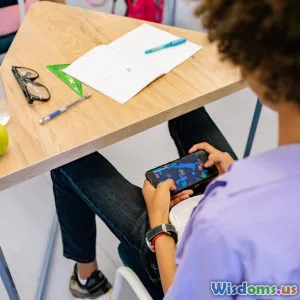
Tech Savvy Classrooms: Tools for Teachers
7 min read Explore how cutting-edge tools create tech-savvy classrooms, empowering teachers and transforming education. (0 Reviews)
Tech Savvy Classrooms: Tools for Teachers
Introduction
Imagine walking into a classroom where technology doesn’t just support learning—it redefines it. The traditional chalkboard has been replaced by interactive displays, and students engage with lessons through virtual reality rather than rote memorization. Technology has reshaped education, providing teachers with powerful tools that amplify student engagement and improve learning outcomes. But what exactly makes a classroom “tech-savvy,” and which tools are empowering educators today?
This article dives into the transformational role of technology in classrooms, focusing on tools that boost teaching effectiveness while inspiring student curiosity and creativity.
The Rise of Tech-Savvy Classrooms
The integration of technology into education isn’t new, but the pace of advancement has accelerated dramatically over the past decade. According to a 2023 report by the National Center for Education Statistics, over 95% of public schools now have access to high-speed internet and digital devices for students. This infrastructure fuels a new wave of tech adoption—from interactive software to immersive simulations.
The COVID-19 pandemic further catalyzed this transition, compelling teachers to rapidly adapt digital tools for remote and hybrid learning. Many institutions found long-term value in these innovations, embedding them permanently into their teaching repertoire.
Essential Tools Educators Use in Tech-Savvy Classrooms
1. Interactive Whiteboards and Displays
Gone are the days when whiteboards were used purely for note-taking. Modern interactive whiteboards like SMART Boards allow teachers to display dynamic content, annotate in real time, and connect with student devices. This fosters collaborative learning and makes abstract concepts tangible.
Example: A biology teacher can display 3D models of the human anatomy, highlighting parts interactively to engage kinesthetic learners.
2. Virtual and Augmented Reality (VR/AR)
VR and AR bring immersive experiences directly into the learning space. This technology enables students to explore historic landmarks, step inside a chemical molecule, or travel through the solar system without leaving the classroom.
According to a 2022 study published in Computers & Education, VR-based lessons improved students’ retention by 20% compared to traditional methods.
Example: Google Expeditions allows students to virtually tour archaeological sites, deepening understanding through experiential learning.
3. Learning Management Systems (LMS)
Platforms such as Canvas, Moodle, and Google Classroom streamline content delivery, grading, and communication between teachers and students. LMSs enable personalized learning paths and track progress efficiently.
Real-world insight: Dr. Clara Jenkins, an education technology specialist, notes, "LMS give teachers the ability to tailor activities and resources based on student performance, greatly enhancing differentiated instruction."
4. Gamification Tools
Integrating game elements into learning can boost motivation and engagement. Tools like Kahoot!, Quizizz, and Classcraft transform quizzes and lessons into interactive competitions.
According to a 2021 survey by EdSurge, 78% of teachers reported increased student participation after gamifying their lessons.
5. Digital Collaboration Tools
Applications like Padlet, Jamboard, and Microsoft Teams facilitate collaboration, allowing students to contribute ideas jointly, regardless of their location.
Example: Using Google Jamboard, a language teacher can host real-time brainstorming sessions enabling students to co-create vocabulary mind maps.
6. Assistive Technologies
Tech-savvy classrooms also embrace accessibility. Tools like speech-to-text software and screen readers empower students with disabilities to participate fully in lessons.
The implementation of such tools aligns with the Universal Design for Learning (UDL) framework, ensuring equitable education opportunities.
Benefits of Technology for Educators and Students
Enhancing Engagement and Motivation
Interactivity and multimedia capture students’ attention far better than traditional lectures. The multisensory involvement offered by digital tools caters to various learning styles—visual, auditory, and kinesthetic.
Facilitating Instant Feedback and Assessment
Teachers can quickly assess student understanding through online quizzes and formative assessment tools, enabling timely interventions.
Encouraging Critical Thinking and Creativity
Technology fosters inquiry-based learning. For instance, students can use coding platforms such as Scratch to create digital stories, enhancing problem-solving skills.
Bridging Cultural and Geographic Gaps
Virtual field trips and global classroom connections expand perspectives beyond the physical classroom walls. This fosters cultural empathy and global citizenship.
Challenges and Considerations
While technology offers remarkable advantages, challenges remain. Teacher training is critical—research shows that only 58% of educators feel confident integrating new tech tools effectively (Education Week, 2023).
Financial constraints also pose barriers. Cutting-edge devices and subscriptions can strain school budgets, especially in underserved areas.
Privacy and data security must also be managed carefully; student data protection is paramount as digital footprints expand.
Conclusion
A tech-savvy classroom isn’t just about having the latest gadgets—it’s about harnessing the right tools to create richer, more inclusive, and engaging learning experiences. From interactive whiteboards to virtual reality, teachers have an expanding toolkit to empower every learner.
Looking forward, continuous professional development and thoughtful integration will be key. As Dr. Jenkins emphasizes, “The future of education belongs to those who can blend technology with pedagogy, sparking curiosity and critical thinking.”
By embracing these innovations, educators can transform classrooms into vibrant hubs that prepare students for a dynamic, technology-driven world.
References
- National Center for Education Statistics (2023). Digital Access and Usage in Schools
- Radianti, J., et al. (2022). The Impact of Virtual Reality on Educational Outcomes. Computers & Education.
- EdSurge (2021). Teacher Survey on Gamification in Education
- Education Week (2023). Teacher Confidence in Ed Tech Integration
- Google for Education. Expeditions and Jamboard Tools
Rate the Post
User Reviews
Popular Posts
















